NGC 5617
NGC 5617 is an intermediate age open star cluster that resides in the Centaurus constellation and shares a binary open cluster with Trumpler 22. NGC 5617 was discovered by James Dunlop on May 8th 1862. This cluster is situated south of the celestial equator, and is therefore more easily visible from the southern hemisphere.
In a study by Orsatti et al (2010) it was determined that there are five blue stragglers and two red giants in the surrounding region of the star cluster. However, the exact members in this cluster are still to be exactly determined.
I collected a total of 15 photos for processing in order to study NGC 5617 and investigate the relationships between the cluster’s colours, brightness levels, age, and chemical composition. I have collected five images each in the B, R and V filters. Furthermore, the exposure durations for each filter include 47.24s in the B filter, 23.62s in the V filter, and 15.75s in the R filter. Afterglow was used to obtain the photometric data, along with collecting the final image of the cluster.
NGC 5617 – Images
The telescopes used for the observation include PROMPT-MO-1, Prompt5, and Prompt6 using Skynet and were used to take the following images:
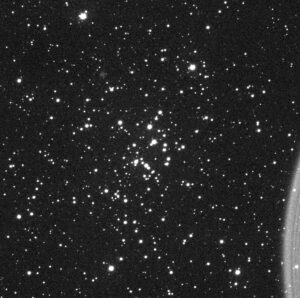
NGC 5617 in the B-filter
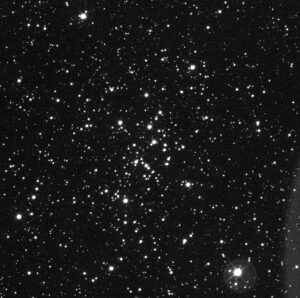
NGC 5617 in the R-filter

NGC 5617 in the V-filter
The resulting images were made using the above filtered images using Afterglow:
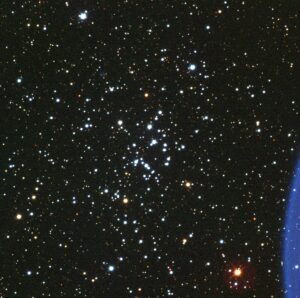
Apparent image of NGC 5617

De-reddened image of NGC 5617
Based on these images, I could identify one fairly bright red giant in the bottom right of the image. Furthermore, on the right of the image there is a strange blue streak which may be due to the telescopes or the surrounding environment.
NGC 5617 – My Obtained Data
Finally, Cluster Astromancer was used to obtain the graphs and further data on the cluster. This data includes:
| Proper Motion Right Ascension
(PM RA – ms/yr) |
Proper Motion Declination
(PM DEC – ms/yr) |
Distance (kpc) | Log Age (yrs) | Metallicity (solar) | Reddening (mag) |
|
-5.67 (mas/yr)
|
-3.21 (mas/yr)
|
1.85 | 8.75 | 0.7 | 0.3 |
NGC 5617 – My obtained graphs
Obtained graphs:


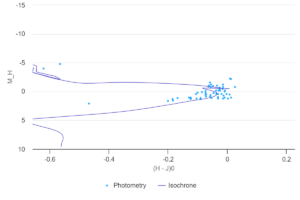
I spent a fair amount of time on these graphs, as I personally found it difficult to fit all of the stars within the graphs, even when tweaking the values for the distance, age, metallicity and extinction.
NGC 5617 – MWSC Catalogue Data
In contrast, a study made by Kharchenko et al (2013) found the following parameters for NGC 5617:
| Distance (kpc) | Log Age (yrs) | Metallicity (solar) | Reddening (mag) |
|
1.769
|
8.25
|
0.7 |
0.5
|
NGC 5617 – Data Comparisons
This is the resulting comparison between my own data and the MWSC data:
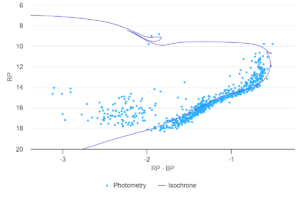
MWSC Data

My Data
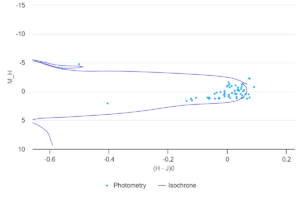
MWSC Data

My Data
NGC 5617 – Comparison Reflection
Overall, the results that were measured through the MWSC catalogue was more accurate than my results. The stragglers near the left were incorporated into the graph in a much better way, alone with a better curve near the left of the graph. However, the values I obtained were not very far off from the obtained values.
The purpose of this research was to learn more about the star clusters and obtain additional data from it. I believe I learned a lot during this analysis, such as how to identify different stars such as red giants and blue stragglers and how to use different filters to obtain colour-images of stars. I believe this analysis has given me a larger appreciation for astronomy as a whole, as this experience was very eye opening and quite fun to do.
NGC 5617 – Conclusion
Overall, the analysis of star cluster NGC 5617 was an intriguing experience. I got to learn more about how the analysis process for stars works, despite some challenges throughout the way such as setting up the graphs. However, this was quite the rewarding and fun analysis to do as well, especially with assembling the filters to create the final images.